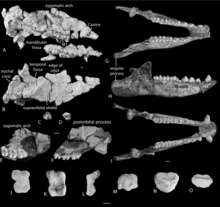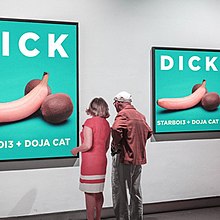안트라코부누스과
Anthracobunidae| 안트라코부누스과 시간 범위: | |
|---|---|
 | |
| 무연골의 두개골 요소 | |
| 과학적 분류 | |
| 왕국: | 애니멀리아 |
| 문: | 챠다타 |
| 클래스: | 젖꼭지 |
| Clade: | †안트라코부니아 |
| 패밀리: | †안트라코부누스과 웰스 앤 진저리치, 1983년 |
| 속[1][note 1] | |

Parsimony는 Cooper 등(2014)[1]의 클래디스트 연구에서 무연고부니드의 계통 발생에 대한 합의 나무를 분석하여 데스모스티리아 옆의 Perissodactyla에 위치하는 것을 보여준다.
안트라코부니과(Anthracobunidae)는 에오세 초기부터 중기까지 살았던 멸종된 줄기 주변액틸류 과이다.그들은 원래 Moeritheriidae와 desmostylians의 조상일 가능성이 있는 원시 프로보사이드의[3] 측계통 과로 여겨졌다.그 가족은 또한 사이렌의 [4]조상인 것으로 여겨져 왔다.
외관상으로는 치아의 크기와 형태 모두 Moeritheriidae와 비슷하지만, 특징적인 엄니가 없다.그것들은 길이가 1미터에서 2미터 사이즈의 비교적 작았다.인도-파키스탄 아대륙 북서부의 에오세 퇴적물에서 나온 단편적인 잔해(주로 치아)로만 알려져 있다.잘 보존된 턱과 이빨을 가진 최근 발굴된 화석은 이 동물들이 주변동물이거나[1][5] 주변동물들과 더 원시적인 자매 그룹의 일부였다는 것을 보여준다.[6]안트라코부니드는 아마 수륙양용이었을 것이고 습지 환경에서 살았을 것이다.안정적인 동위원소와 긴 뼈 형상의 분석에 따르면 대부분의 무연골은 육생식물을 먹지만 [1]물 근처에 살았다.이들의 새로운 배치를 촉발한 동일한 분지학적 분석은 또 다른 추정 비 아프리카 아프로테리아 그룹인 반수성 해양 데스모틸리안류가 [1][6]무연골과 밀접한 관련이 있음을 시사한다.
메모들
- ^ 이전에 Anthracobunidae로 [2]분류되었던 이샤테륨, Hsanotherium, Indobune 및 Nakusia는 2014년 분지 분석의 저자에 의해 제거되었으며, 이전에 Philgrimella와 Lammidhania로 언급되었던 대부분의 표본은 Anthracobune로 [1]옮겨졌다.
레퍼런스
- ^ a b c d e f Cooper, L. N.; Seiffert, E. R.; Clementz, M.; Madar, S. I.; Bajpai, S.; Hussain, S. T.; Thewissen, J. G. M. (2014-10-08). "Anthracobunids from the Middle Eocene of India and Pakistan Are Stem Perissodactyls". PLOS ONE. 9 (10): e109232. doi:10.1371/journal.pone.0109232. PMC 4189980. PMID 25295875.
- ^ 고생물학 데이터베이스의 안트라코부니과.2013년 7월 취득.
- ^ Gheerbrant, E; D. Donming; P. Tassy (2005). "Paenungulata (Sirenia, Proboscidea, Hyracoidea, and Relatives)". In Kenneth D. Rose; J. David Archibald (eds.). The Rise of Placental Mammals: Origins and Relationships of the Major Extant Clades. Baltimore: Johns Hopkins University Press. pp. 84–105. ISBN 080188022X.
- ^ Wells, N.A.; Gingerich, P.D. (1983). "Review of Eocene Anthracobunidae (Mammalia, Proboscidea) with a new genus and species, Jozaria palustris, from the Kuldana Formation of Kohat (Pakistan)" (PDF). Contrib. Mus. Pal. Univ. Michigan. 26 (7): 117–139. OCLC 742731409.
- ^ Qiu, L. (2014-10-08). "Ancient "Oddball" Mammal Reshuffles Family Tree?". National Geographic Society. Archived from the original on 2014-10-11. Retrieved 2014-10-11.
- ^ a b Rose, K.D.; Holbrook, L.T.; et al. (2019). "Anatomy, relationships, and paleobiology of Cambaytherium (Mammalia, Perissodactylamorpha, Anthracobunia) from the Lower Eocene of western India". Journal of Vertebrate Paleontology. 39 (sup1): 1–147. doi:10.1080/02724634.2020.1761370. S2CID 226263139.


